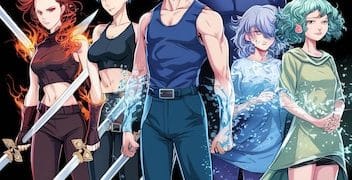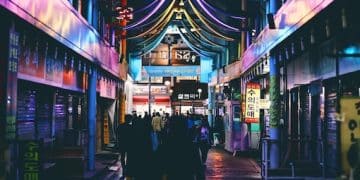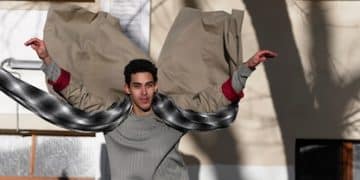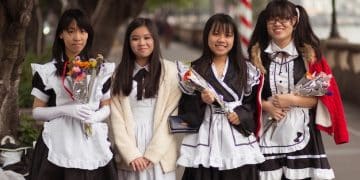The Influence of Traditional Japanese Arts on J-Drama Aesthetics: A Visual Analysis
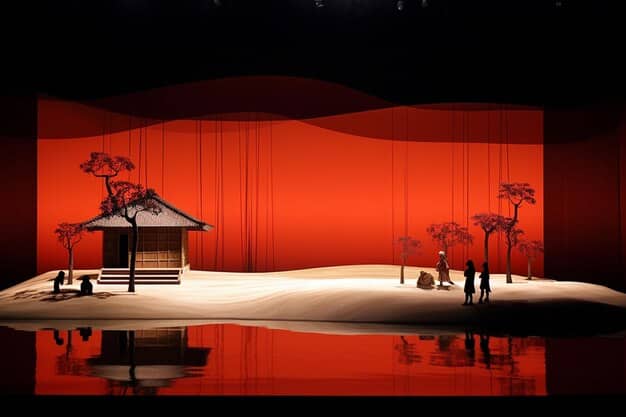
The influence of traditional Japanese arts on J-Drama aesthetics is profound, shaping visual storytelling through elements like calligraphy, landscape painting, and traditional theater, enriching narrative depth and cultural resonance.
The world of J-Dramas, or Japanese dramas, is visually captivating, and much of its unique aesthetic owes a debt to the rich tapestry of traditional Japanese arts. This article explores the profound influence of these arts on J-Drama visuals, offering a deep dive into how elements of calligraphy, landscape painting, and traditional theater subtly and powerfully shape the storytelling experience. From set design to cinematography, the echoes of Japan’s artistic heritage resonate, creating a distinct and culturally rich viewing experience. We will embark on **the influence of traditional Japanese arts on J-Drama aesthetics: a visual analysis** that considers various influences.
Understanding the Foundations: Traditional Japanese Arts
Japanese art is a diverse field incorporating design principles and motifs from across the world. The enduring legacy of these arts influences modern visual media, including J-Dramas. Many art forms have unique features and themes.
Let’s examine a few important art forms:
Calligraphy (Shodō)
Shodō goes beyond mere writing; it is an art form that emphasizes the beauty and expressiveness of brushstrokes. The way ink flows and the character is given life through each stroke. In J-Dramas, the visual drama and emotional weight come from calligraphy.
Ink Wash Painting (Suiboku-ga)
Suiboku-ga, or ink wash painting, uses different shades of black ink to create minimalist and evocative landscapes. It places emphasis on light and shadow. This approach teaches J-Dramas how to use space and how to encourage a sense of atmosphere.
Ukiyo-e (Woodblock Prints)
Ukiyo-e prints, famous for their vibrant colors and depictions of everyday life and landscapes, revolutionized visual art in Japan. In J-Dramas, Ukiyo-e’s dynamic compositions and thematic richness have informed set design, makeup, and costume choices.
Traditional Japanese artistic works are often considered in media production:
- Set Design: Traditional interiors can be designed to reflect the characteristics of Ukiyo-e prints.
- Lighting and Color: The application of the shades and tones featured in Suiboku-ga productions can affect the overall feeling of the scene.
- Costume: This design can be enriched by elaborate forms seen on scrolls and screens.
These traditional aesthetics serve to enrich the J-Drama media environment.
The Influence of Japanese Gardens on J-Drama Aesthetics
Japanese gardens, with their carefully arranged elements and symbolic meanings, greatly influence the visual storytelling in J-Dramas. The thoughtful composition, use of natural elements, and concept of harmony are frequently replicated in cinematic landscapes to emphasize emotional or narrative lines.
Japanese gardens provide many interesting design components:
Composition and Balance
The art of arranging rocks, water, and plants in a garden is about creating visual harmony and balance. J-Dramas use this idea to ensure every scene has a clear visual meaning.
Symbolism and Meaning
Each item in a Japanese garden has its own symbolic value, from koi ponds that represent success to stone lanterns that provide light. J-Dramas use these symbols to enrich storytelling, expressing deeper themes through visual representations.
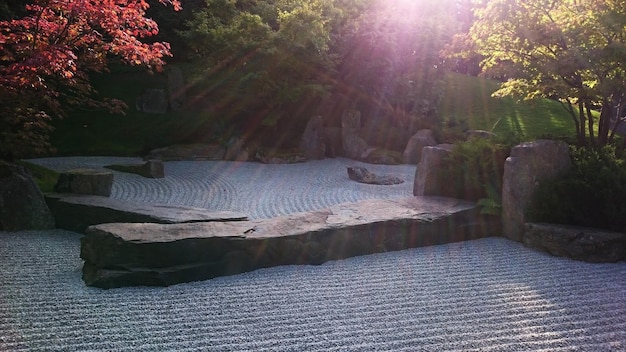
Many visual techniques are common:
- Use of Negative Space: J-Dramas use negative space to draw attention to key plot elements or characters.
- Framing Techniques: The scenic arrangement to enhance the emotional resonance of key scenes.
- Symbolic Imagery: The incorporation of metaphorical elements to suggest narrative depth.
The incorporation of traditional landscape design increases the impact of the art on people who are watching J-Dramas.
Traditional Japanese Architecture in J-Drama Sets
Traditional Japanese architecture with its use of natural materials, minimalist design, and harmony with nature, informs J-Drama set design significantly. The design principles inform the creation of visual contexts to enhance storytelling and evoke cultural authenticity.
Let’s examine the various ways architecture influences J-Drama:
Shoji Screens and Light
Shoji screens diffuse light; the result is a soft, ambient glow that improves the overall mood and visual aesthetics of this environment. The use of such screens can change interior scenes.
Tatami Mats and Spatial Design
Tatami mats not only set the dimensions of a space but also promote respect and modesty. Using the mats affects the layouts of the set, and it influences how actors move and communicate with one another.
Engawa (Verandas) and Transition
Engawa are transitional spots that blur the distinction between inner and outside, bringing nature into ordinary life. J-Dramas utilizes engawa to visually enhance transitions and encourage contemplation.
Japanese architecture greatly influences J-Drama aesthetics.
The Art of Kimono and Traditional Dress in J-Dramas
Kimono and traditional garments are more than just clothes; they are an expression of cultural identity, history, and artistic beauty. J-Dramas use these garments to depict characters, situations, and thematic components of their narratives.
The kimono’s elegance is often featured.
Kimono as a Symbol of Character
Kimono in J-Dramas is a way to reveal the characters’ personalities, social standing, and emotional state. The patterns represent qualities like fortitude, grace, and sophistication.
Color Psychology in Costume Design
The colors of Kimono have meanings: red for passion, blue for calm and black for mystery. J-Dramas use the psychology of color to reinforce narrative themes and evoke emotions.
Historical Accuracy vs. Modern Adaptation
J-Dramas often balance the need for historical accuracy with modern aesthetic preferences. Kimonos can give information while remaining relatable to today’s audience.
Kimono impacts many aspects of the production:
- Symbolism: Selecting patterns to reflect the personality and state of mind of the protagonist.
- Color Palette: The color palette used to elicit specific feelings from the audience.
- Cultural Context: The cultural context must be carefully preserved at all times in order to prevent misrepresentations about historical settings.
The use of kimono and traditional dress provides depth to J-Drama aesthetics.
Noh and Kabuki Theater Influences on J-Drama Performance
Noh and Kabuki, two of Japan’s most important dramatic traditions, have an influence on J-Drama performance and storytelling methods. The stylized movements, symbolic makeup, and dramatic storytelling have influenced J-Dramas’ visual and acting styles.
Traditional theatre has had a number of influences on the show.
Stylized Movement and Gestures
The precise and symbolic movements in Noh and Kabuki help to communicate emotions and stories nonverbally. It teaches J-Drama actors how to convey significant meaning with small, stylized motions.
Makeup and Visual Storytelling
Kabuki makeup (Kumadori) uses striking patterns and colors to denote personality and sentiment. J-Dramas, although in modern settings, adopt make-up language to accentuate character distinctions and emotional conditions.
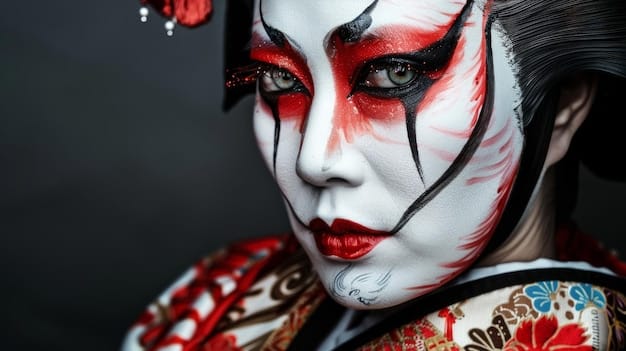
Classical Japanese acting has impacted numerous aesthetics.
- Exaggerated Emotions: It is common for actors to adopt characteristics of Kabuki’s exaggerated expressions of emotion.
- Symbolic Gestures: Some body language may be borrowed or altered to improve the story.
- Dramatic Pauses: Silences are often utilized to allow emotions or meaningful actions to develop.
It influences set decisions and other performance details.
The Role of Japanese Mythology and Folklore
Japanese mythology and folklore, filled with gods, spirits, and legendary creatures, are important sources of inspiration for J-Drama stories and visual elements. The incorporation of supernatural pieces and traditional stories enriches narratives, giving viewers insight into Japan’s cultural past.
Let’s examine various narrative components:
Visual Representation of Yokai (Spirits)
Yokai, or spirits, in Japanese folklore are frequently shown in J-Dramas with creative and symbolic images. This gives the series a fantasy aspect while also paying homage to Japan’s spiritual traditions.
Folktales and Morality
Many J-Dramas are based on old folktales, teaching morals and cultural values to modern audiences. The programs combine history with contemporary themes to enhance teaching value.
Festivals (Matsuri) and Rituals
Matsuri are vibrant showcases of Japanese culture, replete with rituals, costumes, and social importance. J-Dramas uses festivals to bring cultural events to television.
Traditional stories enhance many story aspects:
- Symbolic motifs: The use of mythical objects in dramatic settings.
- Moral messages: Integration of Japanese moral values into the story.
- Cultural Practices: Showing viewers rituals from various matsuri festivals.
The integration of folklore helps the narrative impact of all production media.
Modern Interpretations and Blending of Styles
While J-Dramas are deeply rooted in traditional Japanese arts, they also demonstrate a remarkable ability to blend these ancient aesthetics with modern storytelling techniques. The meeting creates a visually rich tapestry that appeals to both local and international viewers.
The styles are blended using a collection of modern techniques:
Contemporary Themes and Traditional Settings
J-Dramas frequently put current concerns within the context of traditional Japanese locations and aesthetics. This helps investigate social issues from a distinctly cultural viewpoint.
Incorporating Western Aesthetics
J-Dramas can incorporate Western cinematic techniques and visual styles, blending them with Japanese aesthetic principles to create a hybrid visual language that appeals to a global audience.
Use of Technology and Digital Art
The use of digital technology to reproduce traditional art forms has resulted in aesthetically stunning images that enrich J-Drama’s visual offering. This enables modern viewers to access culture in fresh ways.
Modern storytelling is used in several ways:
- Visual Effects: The construction of computer visuals is often impacted by the use of traditional artistic elements.
- Narrative Adaptations: Classic stories are modified to satisfy the tastes of viewers.
- Cross-cultural Appeal: Integration of worldwide concerns in storylines to engage a larger audience.
Contemporary J-Dramas use traditional aesthetics for more impactful results.
| Key Element | Brief Description |
|---|---|
| 🎨 Calligraphy | Influences the visual drama and emotional impact through expressive brushstrokes. |
| 🏯 Architecture | Shapes set design with elements like shoji screens and tatami mats, enhancing authenticity. |
| 👘 Kimono | Conveys character traits and emotional states through color and pattern symbolism. |
| 🎭 Theater | Informs performance techniques through stylized gestures and dramatic makeup. |
FAQ
▼
Calligraphy, or Shodō, emphasizes the beauty and expressiveness of brushstrokes, impacting the visual drama and emotional weight in J-Dramas through set design elements and character representation.
▼
Traditional architecture, such as the use of shoji screens and tatami mats, significantly shapes J-Drama set design, enhancing cultural authenticity and creating unique spatial dynamics.
▼
Kimonos in J-Dramas serve as a visual language, conveying character personalities, social standing, and emotional states through their patterns, colors, and overall design.
▼
Noh and Kabuki influence J-Drama performance through stylized movements, symbolic gestures, and dramatic makeup, all contributing to heightened emotional expression.
▼
Japanese mythology and folklore inspire J-Drama stories and visual elements by incorporating supernatural elements, folktales, and cultural rituals, grounding the narratives in Japan’s cultural heritage.
Conclusion
In conclusion, the aesthetics of J-Dramas are heavily influenced by traditional Japanese arts, including calligraphy, painting, architecture, clothing, theatre, and mythology. Each component enriches visual storytelling, enhances cultural authenticity, and connects modern audiences with Japan’s rich artistic legacy.
